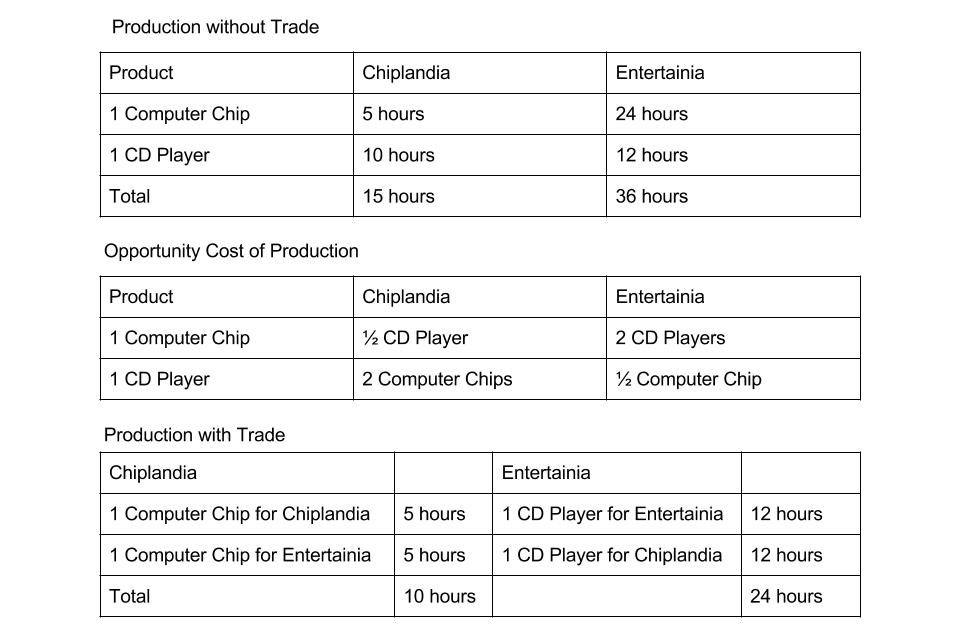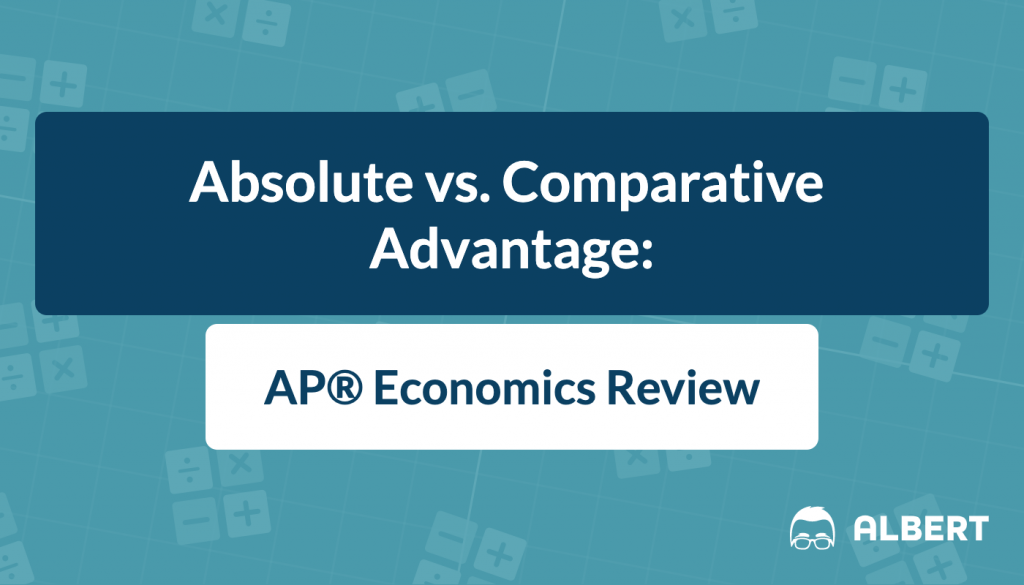If you’ve started studying for the AP® Microeconomics or AP® Macroeconomics exam, then you’ll need to know the essential concepts. One of the most important distinctions you’ll come across in your studies is absolute vs. comparative advantage. So what’s the difference between these two concepts? And why are they so important? That’s what you’ll learn in this post as we review absolute vs. comparative advantage!
First, let’s jump straight into the definitions, and then we’ll take a step back to break each concept down and build our intuition.
Definitions of Absolute vs. Comparative Advantage
Absolute advantage refers to the person or country who can produce a good or service for the least resource cost.

Comparative advantage refers to the person or country who can produce a good or service for the lowest opportunity cost.

A Simple Example
All right, so there are costs associated with both of these, but what do we mean by costs? The cost associated with absolute advantage is the type of cost we’re used to thinking about. For instance, say in one hour Bryan can chop 20 pieces of firewood, while Rick can chop 10. Casually, you’d think to yourself Bryan’s better at chopping firewood. But in economic terms, you’d also think, Bryan has the absolute advantage at chopping wood.
So what’s the difference between resource cost and producing a good or service at the lowest opportunity cost? The difference between opportunity and resource cost is what underpins the difference between absolute vs. comparative advantage. Rather than the resource cost for someone to produce a good or service, the opportunity cost is how much someone gives up to produce a good or service. That is, what was the person’s next-best option?
To build on our intuitive example, let’s extend our camping story a bit further than just chopping wood. Bryan and Rick will also need a tent to sleep in. Suppose that it would take each one of them one hour to pitch a tent alone. Who has the comparative advantage in pitching tents? To find that, we need to find who has the lower opportunity cost for pitching a tent.
In our example, what Bryan gives up, his next-best option, is that he could have chopped 20 pieces of firewood. For Rick, he could have chopped 10 pieces of firewood. If Rick spends his hour pitching a tent, he’s giving up less than if Bryan were too. So Rick has the comparative advantage in pitching tents because he has the lowest opportunity cost, because he gives up the least.
The Importance of Absolute vs. Comparative Advantage
So, what exactly makes absolute vs. comparative advantage so important? Aside from their importance in your AP® Macro or AP® Micro review, that is.
What we’ll see is that these concepts set the stage for why people would trade in the first place. Why we wonder, would someone who is just better at producing everything ever want to trade instead of simply taking the time to produce it themselves? The answer, which we will see as we consider some free response questions, is comparative advantage.
In essence, what we’re wondering about is the difference between absolute vs. comparative advantage. And this concept extends further than just why individuals would decide to trade, or how Bryan and Rick divvy up their tasks! By understanding absolute vs. comparative advantage, we’ll be able to understand both why countries would trade with each other and the patterns of trade we can expect to see.Understanding comparative advantage will be key to seeing how trade can benefit both parties!
These concepts are not only crucial for acing your AP® Micro or AP® Macro exams, but also for setting a foundation from which to begin your AP® Economics review!
Unpacking a More Complicated Example
OK, so now you’ve got the intuition down, and you know why absolute vs. comparative advantage is such an important concept for your AP® Economics review. But what you’re here for is AP® Macro review and AP® Micro review, and that means that you also want to know how absolute vs. comparative advantage is likely to show up on the test.
First, you’ll need to be able to answer questions about tables, like this, taken from the 2016 AP® Macroeconomics exam:
The following table shows the number of donuts or cupcakes that John and Erica can each produce in one day.
| Donuts | Cupcakes | |
| John | 200 | 100 |
| Erica | 150 | 50 |
Let’s work through this example step-by-step.
First, who has the absolute advantage in donuts and cupcakes? We see that John can produce more of both products in a day, meaning that John has the absolute advantage in donuts as well as in cupcakes. How about the comparative advantage? Who has the comparative advantage in producing donuts? For that, we first need to figure out the opportunity cost of producing a donut.
That is, what does each person give up to produce each donut? In a day, John can make 200 donuts or 100 cupcakes, which means that in the time it takes John to make one donut, he could have made ½ of a cupcake. We find this by taking the ratio of how many cupcakes he can make in a day (100) to how many donuts he could make in a day (200). And just like that, we have the opportunity cost. The opportunity cost to John of making a donut is ½ of a cupcake.
But for comparative advantage, we need to know who has the lowest opportunity cost. So we need to repeat this process for Erica: What is Erica’s opportunity cost of producing a donut? Following the same steps we used for John, we see that for Erica to make one donut, she must give up 1/3 of a cupcake.
Comparing the two individuals’ opportunity costs, we see that while John is better at producing both donuts and cupcakes and, thereby, has an absolute advantage in both, Erica has the lowest opportunity cost of producing a donut ( vs. John), and therefore has the comparative advantage in making donuts.
But surely John has a comparative advantage in something? Indeed, if we ask who has the comparative advantage in cupcakes, we will find that it’s John. For John to make one cupcake, he must give up 2 donuts. While in the time it takes Erica to make one cupcake, she could have made 3 donuts. So John has the comparative advantage in cupcakes.
This comparative advantage sets the stage for John and Erica to specialize and trade! Assume that each specializes in that person’s own comparative advantage, so that John produces 100 cupcakes and Erica produces 150 donuts. Now to decide if trading is beneficial, we need to know how many donuts trade for how many cupcakes. Assume that one cupcake can be exchanged for four donuts.
If John always wants to eat 100 donuts, then without trading, he could have used his day to produce 100 donuts and 50 cupcakes. We find this from opportunity costs as well! We know that for every donut John makes, he is giving up making ½ a cupcake. If he makes 100 donuts, he gives up 50 cupcakes from the maximum number he could make in a day. But with trade, there’s another possibility for John. He can specialize in cupcakes (since it’s his comparative advantage) and make 100 of them. Then he can trade 25 cupcakes to Erica for 100 donuts. That means, with trade, John now has 100 donuts, as he did without trade, but 75 cupcakes! By trading, John can have 25 more donuts! So, for John, trade is surely beneficial!
But at one cupcake for four donuts, this won’t be the case for Erica. A quicker way to see this is by comparing opportunity costs to the exchange rate. To make 1 cupcake, Erica gives up 3 donuts. But for Erica, we see trading does not offer a better option since 1 cupcake is traded for 4 donuts.
What Can You Expect From a Free Response Question?

So we’ve seen how absolute vs. comparative advantage can tell us why people would specialize and trade, but what about countries? Let’s use another example to apply what we’ve learned to countries. Consider another free response question, this one from the 2015 AP® Macroeconomics exam:
Country X and Country Y are trading partners, and both produce furnaces and solar panels. The countries can produce the following amounts using equal amounts of resources.
Country X: 6 furnaces or 8 solar panels
Country Y: 6 furnaces or 12 solar panels
Applying what we did in the last question, we see that while neither country has an absolute advantage in furnaces, Country Y has an absolute advantage in solar panels. What about comparative advantage? We now know that the first step for deciding that is checking for opportunity costs!
The opportunity cost of one furnace for Country X is that they could have made one and 1/3 solar panels. For Country Y, in order to make one furnace, they have to give up the resources that could have made 2 solar panels.
So who has the comparative advantage in producing furnaces? Country X, precisely because the opportunity cost of producing a furnace is lower for Country X than it is for Country Y.
Finally, if two furnaces can be traded for 1 solar panel, should Country X produce the solar panels domestically, or import them from Country Y? As we did with John and Erica’s trading, let’s break this down in a way that compares to opportunity costs.
At this exchange rate, Country X knows that it could trade one furnace for of a solar panel. But domestically, the opportunity cost of that furnace for Country X would be 1 solar panels. So Country X could make more solar panels by shifting resources domestically rather than trying to trade for them at this exchange rate with Country Y.
Conclusion
The difference between absolute vs. comparative advantage is one of the most crucial concepts to understand in any AP® Economics Review since it forms the building blocks you’ll need for both AP® Macro review and AP® Micro review. This post helped you understand absolute vs. comparative advantage, which gives you the tools that you need in order to understand trade between persons as well as trade between countries. You can now see both why it can be, and when it will be beneficial for countries or persons to engage in trade. So, how could it be beneficial for a country to trade with another country that is absolutely worse at producing everything?
Looking for more AP® Macroeconomics practice?
Check out our other articles on AP® Macroeconomics.
You can also find thousands of practice questions on Albert.io. Albert.io lets you customize your learning experience to target practice where you need the most help. We’ll give you challenging practice questions to help you achieve mastery of AP Macroeconomics.
Start practicing here.
Are you a teacher or administrator interested in boosting AP Macroeconomics student outcomes?
Learn more about our school licenses here.









2 thoughts on “Absolute vs. Comparative Advantage: AP® Economics Review”
“To make 1 donut, Erica gives up 3 cupcakes.”
You worded that wrong; Erica gives up 3 donuts every time she makes one cupcake because 150/50 = 3.
Thanks for catching the mistake. We’ve updated the article.
Comments are closed.